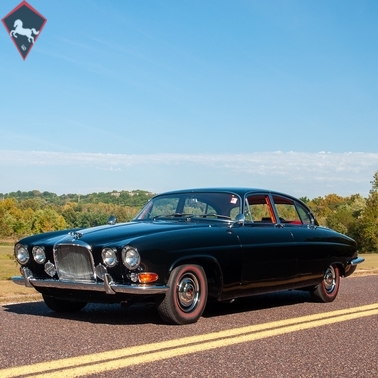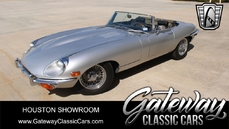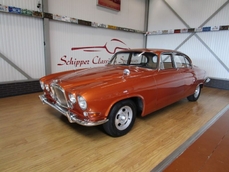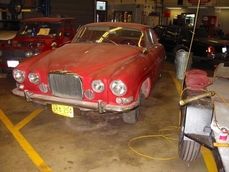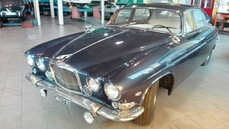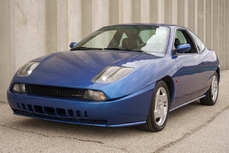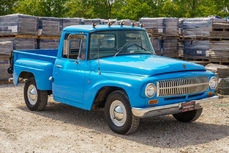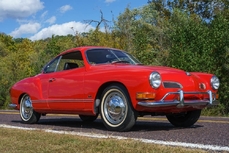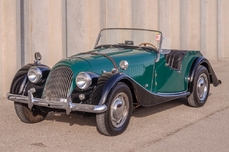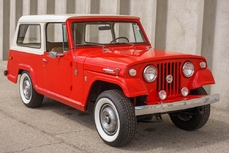Jaguar MK X 3.8L straight six 1964
General description :
1964 Jaguar Mark X Saloon
Previously owned/titled by real estate mogul Richard Parkoff of the Parkoff Organization
Parkoff commissioned a no expense spared restoration on this Mark X in Southern Florida
One of 5,775 Mark Xs exported in 1964
First Jaguar Saloon to feature independent rear suspension
Black exterior with rich red leather interior
3.8L inline six-cylinder engine with triple SU carburetors
Borg-Warner DG 250 three-speed automatic transmission and 3.54 gearing
Air-conditioning, power steering, power four-wheel disc brakes and power windows
Rear seats feature fold-down trays and fold-down center armrest
Redline Coker Classic tires to match the red interior
Comes with Jaguar Daimler Heritage Trust certificate
Own this Vehicle from $639 per month-call 636-600-4600
Seeking a classic British Executive Luxury Saloon finished in desirable black exterior and rich red leather interior that has benefited from a no expense spared extensive restoration by Mr. Executive himself, real estate tycoon Richard Parkoff! MotoeXotica Classic Cars is pleased to present this handsome 1964 Jaguar Mark X Saloon.
Made on March 16, 1964 at Jaguar’s Coventry, England factory, . It was dispatched on April 7, 1964 via Jaguar Cars in New York, NY. With the most recent owner being Richard Parkoff of the Parkoff Organization, a massively successful New York City real estate firm. In 2008 the Parkoff Organizaion making headlines with New York City’s largest ever all-cash deal in real estate. Since then the organization has made multiple other multimillion dollar deals in and around New York City. Making the Parkoff Organization one of the premier real estate firms in New York City.
With money being no object, about 10 years ago, the car was repainted and reupholstered – the exterior is finished in a stunning black exterior while the interior is finished in rich red leather that absolutely smells wonderful. The paint and trim are in excellent overall condition. The windows are clear and intact while the car’s lights are haze-free and intact. The car’s bodywork is straight and solid including the chrome bumpers.
The area under the bonnet (hood) is extremely tidy, the battery appears new while the boot (trunk) is in very good overall condition, complete with full-sized spare tire and cover. This classic cat rolls on Coker Classic redline tires, size P195/70R14 at all four corners and each tire is mounted on a steel wheel topped with factory wheel cover. The tires and wheel covers are all in very good order.
Under the hood is Jaguar’s venerable 3.8L straight six motor breathing via triple SU carburetors and dual exhausts and backed by a Borg-Warner DG250 three-speed automatic transmission and a 3.54:1 rear end. Driver convenience features include air-conditioning, power steering, power four-wheel disc brakes and power windows.
Inside, the car’s red leather interior is quite eye-catching and complements the exterior well. The supple leather is very inviting and the burled walnut accents on the door panels, instrument panel and center console inject warmth. The front and rear seats are in excellent shape, as is the matching carpet. The factory two-spoke steering wheel is present and looks great. The dashboard and inner door liners are in nearly impeccable condition. Even the center console looks fantastic. The interior was Jaguar’s last to feature abundant standard woodwork, including the dashboard, escutcheons, window trim, a pair of large bookmatched fold out rear picnic tables, and a front seat pull-out picnic table stowed beneath the instrument cluster.
The Jaguar Mark X (Mark Ten) was British manufacturer Jaguar’s top-of-the-range saloon for a decade, from 1961 to 1970. The large, luxurious Mark X succeeded the Mark IX as the company’s top saloon model and was primarily aimed at the United States market. The company hoped to appeal to heads of state, diplomats and film stars.
Introduced in the same year as Jaguar’s iconic E-Type, the Mark X impressed with its technical specification and innovations. Contrary to its predecessors, the car featured integrated, unitary bodywork – the largest in the UK at the time, as well as independent rear suspension, unheard for early 1960s British luxury cars. Combined with the 3.8-litre, triple carburetor engine as fitted to the E-type, it gave Jaguar’s flagship a top speed of 120 mph and capable handling at less than half the price of the contemporary Rolls-Royce Silver Cloud.
Despite press acclaim from both sides of the Atlantic, the Mark X never achieved its sales targets. When Jaguar decided to replace its entire saloon range with a single new model, the resulting XJ6 of 1968 used the Mark X as a template – albeit with a reduced size.
In 1961, the Mark X introduced a new upright, and slightly forward-leaning nose design for Jaguar saloons, with four headlamps set into rounded front fenders (derived from Daimler DK400), and a vaned grill. This front-end style reappeared on many of the manufacturer’s successive saloons, up to and including the X-Type and third generation Jaguar XJ, both through 2009 — thereby forging Jaguar saloons’ look for half of a century. In 2008, Jalopnik called the quad round headlight design the classiest headlight configuration and the fourth-best car design element of all time, mentioning Jaguar specifically.
Instead of relying on body-on-frame construction, like its predecessors and most of its competitors, the Mark X received a unitary construction monocoque body-shell, codenamed “Zenith” during its development. The substantial doors required helical torsion springs inside the door pillars to enable them to be opened from the inside with a low level of effort.
From its introduction in mid-October 1961 until the arrival in 1992 of the low-slung XJ220, the Mark X stood as one of the widest production Jaguars ever built. Asked in 1972 if he thought the Mark X had grown too large, Jaguar chairman William Lyons agreed that it “definitely” had: he opined that the then recently introduced and notably more compact Jaguar XJ6 was, by contrast an “ideal size.”
The Mark X was the first Jaguar saloon to feature independent rear suspension. It differed from earlier large Jaguar saloons in having 14” wheels instead of the more common 15”. It used a wider-track version of Jaguar’s IRS unit first seen on the E-Type, which was subsequently used on Jaguar vehicles until XJ-S production ended in 1996. The front suspension used double wishbones with coil springs and telescopic dampers.
Power initially came from the E-type’s version of Jaguar’s XK inline six-cylinder engine. A 9:1 compression ratio was standard but an alternative 8:1 compression ratio was available as an option. Triple SU carburetors were fitted, fed from an AC Delco air filter mounted ahead of the right-hand front wheel.
Transmission options were manual, manual with overdrive, automatic, or automatic with overdrive. Many domestic market cars and all cars destined for the important North American markets left the factory with a Borg Warner automatic gearbox.
Stopping power for this heavy car came from power-assisted disc-brakes on all four wheels and power-assisted steering was standard.
Documentation includes a Jaguar-Daimler Heritage Trust Certificate and more than $4K in receipts from Mr. Parkoff’s restoration in Florida.
Competition to this Jaguar in 1964 included BMW’s New Class Sedan, Cadillac’s Sedan de Ville, Chrysler’s 300, Mercury’s Park Lane, Oldsmobile’s 98 and Mercedes-Benz’s 600.
Whether you’re a head of state, diplomat or a movie star or not, you should visit MotoeXotica Classic Cars to check out this classic, full-size Jaguar. You won’t see many ‘60s Jaguars on the road, at the car show or cruise night.
VIN: 353588BW EIN: ZB4067-9 TIN: JX10518P BIN: Z13124
This car is currently located at our facility in St. Louis, Missouri. Current mileage on the odometer shows 53,813 miles. It is sold as is, where is, on a clean and clear, mileage exempt title. GET OUT AND DRIVE!!!
Copy & Paste the Link Below to View Our YouTube Video:
https://youtu.be/38DYlGgGRbM
https://www.motoexotica.com/inventory/listing/1964-jaguar-mark-x/
1964 Jaguar MK X 3.8L straight six is listed sold on ClassicDigest in Fenton (St. Louis) by for $42900.
Car Facts
Car type : Car Make : Jaguar Model : MK X Model Version : 3.8L straight six Engine size : 3.8 Model Year : 1964 Sub type : Sedan Location : Fenton (St. Louis)
Sold
Seller Information
Sold
People who viewed this Jaguar MK X also viewed similar Jaguar listed at ClassicDigest
Other cars listed for sale by this dealer
About Jaguar
Ah, the story of Jaguar, from its early days as the SS Cars Ltd. to its pinnacle with the D-type, and the street-going evolution in the form of the iconic E-type. There's something quintessentially British about this tale, and I'll narrate it as a British journalist might.In the Beginnings:
Our journey into the world of Jaguar begins in the 1930s, when a company known as SS Cars Ltd. emerged. Despite the unfortunate coincidence of their initials with the rising political tensions in Europe, they started producing stylish and performance-oriented cars. The SS 100, introduced in 1936, was a symbol of elegance and speed, setting the stage for what would become Jaguar.
The Birth of Jaguar:
As the shadows of World War II loomed, SS Cars Ltd. wisely decided to disassociate themselves from the SS initials. Thus, in 1945, they officially became Jaguar Cars Ltd., a name that would soon be synonymous with British luxury and performance.
The XK Series:
Jaguar's post-war era brought us the XK 120, a true sensation in 1948. With its sleek design and a powerful 3.4-liter inline-six engine, it became the world's fastest production car. The XK 120 was the blueprint for what lay ahead – Jaguars that blended style with speed in a uniquely British fashion.
The D-type Dominance:
Then came the D-type, a true racing legend. Introduced in 1954, it won Le Mans three times in the 1950s, showcasing Jaguar's engineering prowess. With its innovative monocoque construction and the iconic fin at the back, the D-type was the apex of Jaguar's motorsport success.
The E-type Emergence:
But the true turning point arrived in 1961 with the introduction of the E-type, often described by Enzo Ferrari as "the most beautiful car ever made." Its long bonnet, curvaceous body, and a 3.8-liter engine delivering exhilarating performance made it an instant classic. The E-type was not just a car; it was a work of art on wheels, and it could hit 150 mph on the road.
Street and Racing Success:
The E-type's beauty was matched by its capability on the track. The lightweight E-types were particularly successful in various racing events, cementing Jaguar's reputation as a force to be reckoned with in motorsport.
The Age of Refinement:
As we delve deeper into the Jaguar story, we find that the 1950s and 1960s were an age of refinement and expansion. Alongside the magnificent D-type and the E-type's iconic emergence, Jaguar introduced models that further solidified its reputation for luxury and performance.
The MK2:
In the late 1950s, Jaguar unveiled the MK2, a sports sedan that combined elegance with power. This sleek four-door saloon was a favorite of bank robbers and law enforcement alike, thanks to its exceptional speed and handling. The MK2 was a symbol of Jaguar's ability to blend sophistication with performance and had a successful racing career as well.
The XJ6:
Fast forward to 1968, and Jaguar launched a car that would define luxury saloons for decades to come – the XJ6. It was a masterpiece of engineering and design, featuring a smooth inline-six engine, independent rear suspension, and a spacious, beautifully appointed interior. The XJ6 was a symbol of British elegance and provided a ride so smooth that it seemed to glide over the road. It became the flagship model for Jaguar and set the standard for luxury saloons, showcasing a level of refinement that left competitors in awe.
The Blend of Classic and Modern:
While the MK2 and XJ6 represented the evolution of Jaguar's saloon cars, they maintained the brand's commitment to performance and luxury. These cars didn't just belong on the racetrack; they were equally at home cruising down the grand boulevards or gliding through the English countryside.
The Challenges of Change:
However, as the 1970s arrived, Jaguar, like many British automakers, faced financial challenges and changes in ownership. The British Leyland era brought both opportunities and struggles, as the brand navigated through various mergers and transitions.
Nevertheless, the legacy of the MK2 and XJ6, along with the D-type and E-type, continues to define Jaguar as a manufacturer that combines timeless elegance with a spirit of performance. These classic models, whether driven on winding roads or parked as collectors' treasures, serve as a testament to Jaguar's enduring presence in the world of automotive excellence.
The Jaguar story, from its early days as SS Cars Ltd. to the creation of automotive icons like the E-type, MK2, and XJ6, is a journey that reflects the very essence of British motoring – a blend of luxury, power, and style that continues to captivate enthusiasts and connoisseurs alike.
